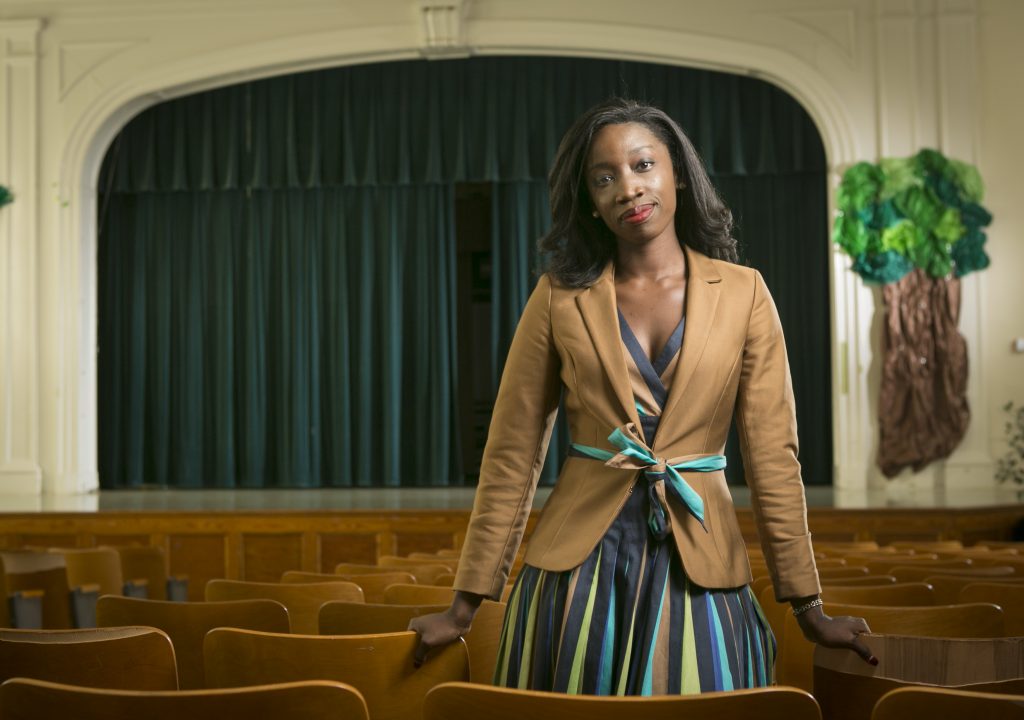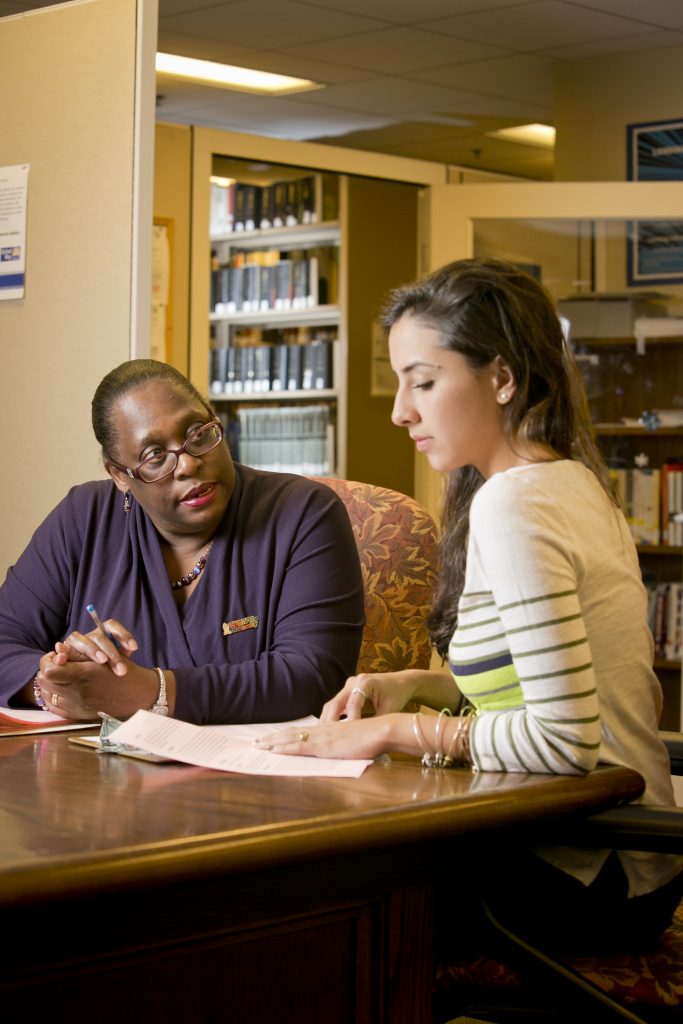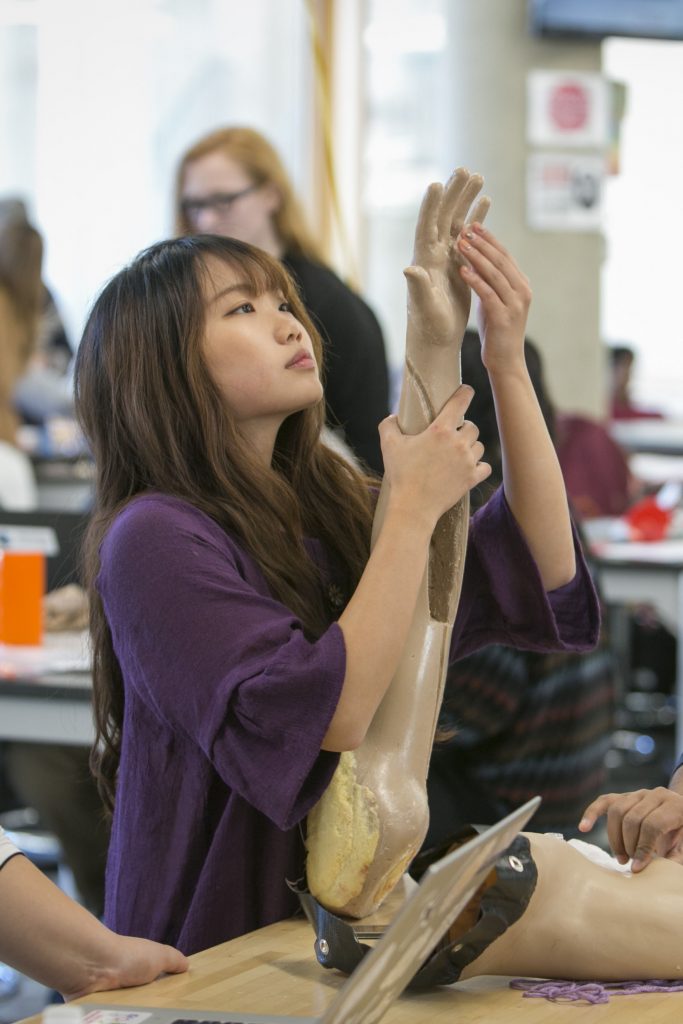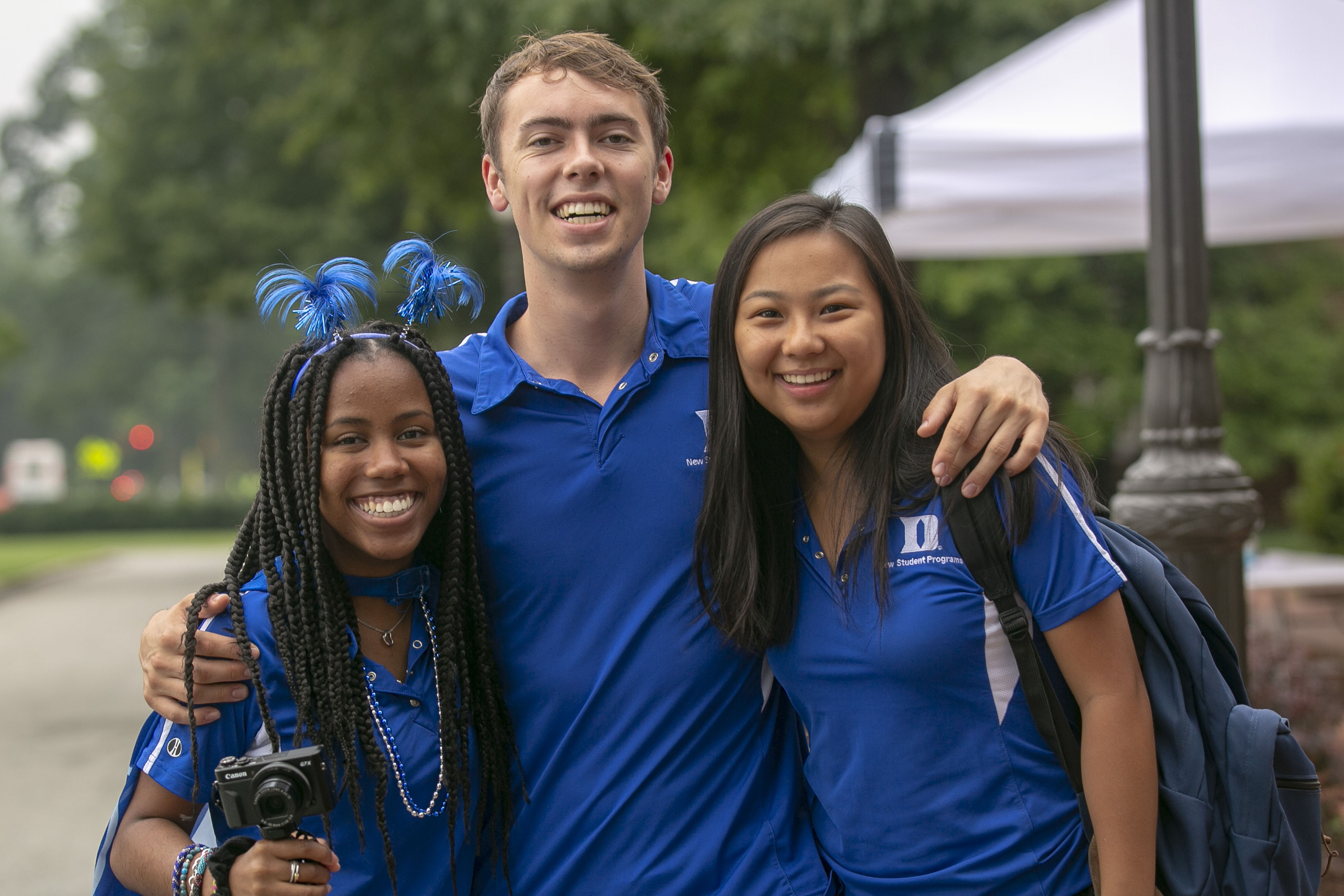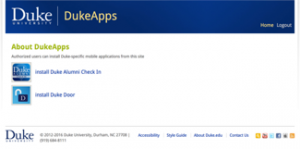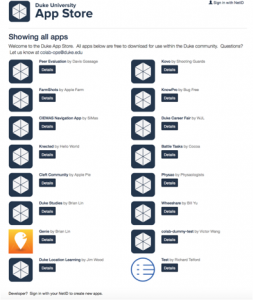| collective nouns |
|
Nouns and proper nouns denoting units (class, choir, committee, fraternity, orchestra, team, Duke, Microsoft) are singular and take singular verbs and pronouns.
The Arts & Sciences Council adjourned for the summer. It meets again in September.
However, team names, band names, etc. take plural verbs and pronouns.
The Beatles remain the world’s most influential band.
The Blue Devils won last night. They dominated on defense.
|
| commas in a series |
|
MarComms style is to avoid Oxford commas.
Use a comma after each item in a series except before the conjunction (unless the last item includes a conjunction.)
Example:
Students eat lunch at the Cambridge Inn, the Alpine Atrium and the Perk.
|
| compose, comprise |
|
Compose
In the passive voice, means to be made up of:Duke University is composed of nine schools.
Comprise
Best used only in the active voice, and means to contain or include.Duke University comprises 10 schools.
|
| compound nouns |
|
When in doubt whether a noun is open (half note, half brother), closed (halfback, halftone), or hyphenated (half-moon, half-life), consult a dictionary. (Also see Prefixes, below.) Note: AP dropped hyphenations for compound proper nouns and adjectives. Some examples: |
| |
African American (no longer hyphenated)
Italian American (no longer hyphenated)
bookkeeping
coal mining
crosswalk
decision-maker
decision-making
ex-president
first-grader
French Canadian
full moon
half-century
half-dollar
headache, toothache
key of G-minor
|
key of B-flat
key of G-major
Latin American
mid-Atlantic
midsummer
near miss
northeast
notebook, textbook
one-half, one-eighth
oversight
policymaker
president-elect
quasi corporation
self-knowledge
vice chairman
vice president
vice provost
|
| dean’s list |
|
Always lowercase
He made the dean’s list three straight semesters.
|
| |
|
|
| disinterested, uninterested |
|
Disinterested means impartial, uninterested means lacking in interest. |
| due to |
|
Due is an adjective that follows the verb to be or modifies a particular noun.
The cancellation was due to snow.
It should not be used in adverbial phrases to mean because of.
Incorrect: Due to snow, classes were canceled.Use: Because of snow, classes were canceled.
|
| Duke’s units, official names |
|
Trinity College of Arts & Sciences
Divinity School
Duke University Health System (lowercase “health system” if on its own)
Duke Health is an umbrella term that refers to all of the component entities — Duke University Health System, Duke University School of Medicine, Duke University School of Nursing, etc.
Duke University Health System refers ONLY to the clinical entities — Duke University Hospital, Duke Raleigh Hospital, outpatient clinics and facilities, and physician practices.
The Fuqua School of Business
Graduate School
Nicholas School of the Environment
Pratt School of Engineering (or Duke Engineering)
Sanford School of Public Policy
Duke University School of Law or Duke Law
School of Medicine
School of Nursing
Undergraduate women who attended Duke between 1930 and 1972 were students in the Woman’s College, not the Women’s College.
See also: Schools and class years, below.
|
foreign words
and phrases |
|
Foreign words and phrases found in a standard English dictionary are not italicized: |
| |
al-Qaida
dolce vita
fait accompli
hacienda
jihad
kibitz
mah-jongg
mea culpa
troika
tsunami
|
Nouns that in German would be capitalized are in English lowercase:
doppelgänger or doppelganger, schadenfreude, weltschmerz.
|
| full time, part time |
|
Hyphenate the adjective, not the noun.
Full-time employees work Monday-Friday.
Employees who work evenings are part time.
|
| fundraising, fundraiser |
|
One word in all cases.
Duke Forward was a fundraising effort.
Fundraising is important to the university’s future.
|
| handicap, disability |
|
Do not use handicap or handicapped to describe someone. Instead refer to the person and their condition, using person-centered language such as a person with a disability |
| he or she, his or her |
|
Using he or she and his or her can be awkward. It is often simpler to make the noun plural.
Instead of:
A student gets good grades when he or she studies hard.
Use:
Students get good grades when they study hard.
|
| historic, history |
|
When the h in these words is pronounced, the indefinite article should be a:
a historic moment
a history professor
|
| hopefully |
|
This adverb means in a hopeful manner.
The students waited hopefully for tickets.
It should not be used to mean it is hoped.
Instead of:
Hopefully, tickets would be available.
Use:
They hoped tickets would be available.
|
| hurricanes |
|
All hurricanes take an indefinite pronoun. Hurricane Fran hit Durham in 1996. It (not she) caused extensive flooding. |
| hyphenation |
|
Compound modifiers before nouns are hyphenated.
The trustees approved a long-term strategic plan.
Exceptions:
Compounds with very and with adverbs ending in –ly.
A D is a very low grade.
A D is not an easily forgotten grade.
Compound modifiers after the verb to be are hyphenated.
The strategic plan is to be a long-term document.
|
| impact |
|
Impact is a noun.
The team’s losing record had an impact on attendance.
Its use as a verb meaning affect or influence is common, but should be avoided.
Instead of:
The team’s losing record impacted attendance.
Use:
The team’s losing record affected attendance.
|
| imply, infer |
|
Speakers and writers imply, listeners and readers infer. |
| institutes |
|
Duke’s six university-wide institutes serve as crucial incubators of innovations in research, pedagogy and civic engagement. More information is at https://sites.duke.edu/interdisciplinary:
Duke Institute for Brain Sciences
John Hope Franklin Humanities Institute
Duke Global Health Institute
Kenan Institute for Ethics
Nicholas Institute for Energy, Environment & Sustainability
Social Science Research Institute
|
| internet, web, etc. |
|
The following capitalizations, spellings and hyphenations are recommended:
app
avatar
blog
cellphone
click-throughs
crowdsourcing
Duke Daily
Duke Today
e-commerce
eBay
email
e-reader (Kindle, Nook)
GIF
geotagging, geolocation
Google, Googling, Googled
hashtag
internet
iPad, iPhone, iPod
iTunes
JPG
mashup
microblogging
online
PDF
smartphone
to text, text message, texted, texting
Tumblr
X, (formerly Twitter) (n.), tweet (v., for now)
Voice over Internet Protocol (VoIP on second reference)
web, website
wiki, Wikipedia
Working@Duke
YouTube (also, Duke’s channel on YouTube) |
| Iran, Iraq |
|
Iran is not an Arab nation. Its people are Persian, Azerbaijani, Kurdish and other ethnic groups.The principal language is Farsi, an Indo-European language, also known as Persian, that is written with Arabic characters. The majority of Iranians are Shiite Muslims, others are Sunni Muslims.
Iraq is an Arab nation. The principal language is Iraqi, a dialect of Arabic. Most Iraqis are Shiite Muslims, others are Sunni Muslims. The Kurds, Sunni Muslims who speak a dialect of Farsi, are a large minority in both countries.
|
| italics, quotation marks |
|
In general, do not use italics or quotation marks for emphasis or to suggest irony or special usage:
Some students questioned whether the painting should be considered “art.”
In particular, do not use italics or quotation marks around clichés or figures of speech:
The tuition increase will have an impact on the university’s “bottom line.”
Nicknames are enclosed in quotation marks.
Harold “Spike” Yoh, former chairman of Duke’s Board of Trustees.
|
| Kmart, Wal-Mart, Hewlett-Packard, Packard Bell, etc. |
|
When in doubt about the spelling and punctuation of company names, check with the press relations department at corporate headquarters. Even official websites may contain errors. |
| lay, lie |
|
Lay (past tense: laid; past participle: laid; present participle: laying) is an action verb meaning to put or place; it takes a direct object.
The student lays down his pencil.
The student laid down his pencil.He has laid down his pencil.
He is laying down his pencil.
Lie (past tense: lay; past participle: lain; present participle: lying) means to be or stay at rest horizontally. It cannot take an object.
The pencil lies on the desk.
The pencil lay on the desk.
The pencil has lain on the desk.
The pencil is lying on the desk.
|
| less, fewer |
|
In general, less refers to things that can be measured, fewer to things that can be counted.
The student had less free time, even though he took fewer classes.
|
| like, as |
|
Like is a preposition that requires an object.
She plays defense like a pro.
As is a conjunction that introduces a clause.
She plays defense as the coach taught her.
|
| local places |
|
Research Triangle Park, then RTP in subsequent references.
The Triangle, and eight-county region in the Piedmont of North Carolina consisting of Chatham, Durham, Franklin, Harnett, Johnston, Orange, Person, Wake.
|
| months, seasons |
|
Months are uppercase, seasons are lowercase. Abbreviate all months with a date except March, April, May, June, July.
May 15.
July 4.
Feb. 13.
Dec. 25.
It was the summer of 1975. We worked hard all winter.
|
| Mohammed |
|
Preferred over Muhammad, Mahomet or other spellings for the founder of Islam. |
| mount, mountains |
|
Mount is spelled out, mountain is capitalized as part of a proper name.
Mount Mitchell is in the Black Mountains.
|
| mm, mph |
|
Do not use periods; abbreviate in all uses.
The White Lecture Hall has 16mm and 35mm film projectors. (Note: No space is used.)
The campus speed limit is 25 mph.
|
| numbers |
|
Spell out whole numbers below 10, use figures for 10 and above.
The department has 15 faculty and two administrative assistants.
Exceptions:
Ages:
She has a son, John, 7.
She has a 7-year-old son, John.
Dimensions:
The photograph is 6 inches by 9 inches.
The sophomore is 6 feet 5. He is a 6-foot-5 sophomore.
Percentages:
AP says use % with no space after the figure, but spelling out “percent” is fine if preferred:
Only 4% of undergraduates do not return for their sophomore year.
The Blue Devils won 84 percent of their home games. (add a space between the figure and percent).
Time:
The class starts at 9 a.m. (Not: 9:00 a.m. or 9 A.M.)
Try to avoid starting a sentence with a figure:
Seventy students enrolled in the class.
Rewrite:
There are 70 students enrolled in the class.
|
| only |
|
Make sure that only modifies what you want it to modify.
He only studies on weekends means that on Saturday and Sunday he does nothing but study.
He studies only on weekends means that he doesn’t study Monday through Friday.
|
| possessives |
|
Singular nouns add an apostrophe and an s.
The team’s record.
The driver’s license.
Exceptions:
appearance’ sake, conscience’ sake, goodness’ sake
The AP Stylebook lists as exceptions singular nouns ending in s and followed by words beginning with s:
the witness’ story, but the witness’s recollection
the hostess’ soirée, but the hostess’s party
Plural nouns add an apostrophe:
the students’ grades
Exceptions:
Plural words used descriptively.
The Blue Devils coach
a writers guide
Names ending in s, add an apostrophe:
Charles’ dog
Jesus’ mother
Moses’ law
Achilles’ heel
Euripedes’ plays
For names ending in z and x, add an apostrophe and an s:
Berlioz’s opera
Marx’s writings
Xerox’s profits
|
| prefixes |
|
Most nouns, verbs, adjectives and adverbs formed with the following prefixes are closed (e.g., anteroom, neoclassical): |
| |
ante (antediluvian)
anti (antihero)
bi (bisexual)
bio (biodiversity)
co (coauthor, cooperate)
counter (counteroffensive)
extra (extracurricular)
infra (infrastructure)
inter (intercollegiate)
intra (intrasquad)
macro (macroeconomics)
meta (metadata)
micro (micromanage)
mid (midcentury)(but: mid-Atlantic)
mini (minibus)
multi (multistory)
neo (neoclassical)
non (nonviolent, nonprofit) |
over (overvalued)
post (postdoctoral)
pre (prearranged)
pro (proconsul) (but: pro-choice,
pro-life, pro-American)
proto (prototype)
pseudo (pseudoscience)
re (reunite, reexamine)
semi (semiannual, semiconductor)
socio (socioeconomic)
sub (substandard)
super (superego, superimpose)
supra (supraorbital)
trans (transoceanic)
ultra (ultraconservative)
un (unenthusiastic)
under (underfunded) |
| ranges |
|
Use this form:
$5 million to $10 million, not $5-10 million
5,000 to 10,000, not 5-10,000
|
| religions |
|
|
Anglicanism (Anglican)
Baptist Church (Baptist)
Buddhism (Buddhist)
Catholicism (Catholic)
Church of Christ, Scientist (Christian Scientist)
Church of Jesus Christ of Latter-
day Saints (Mormon)
Religious Society of Friends (Quaker)
Hinduism (Hindu)
Islam (Muslim)
Judaism (Jew)
Eastern Orthodox churches (Greek Orthodox Church, Russian Orthodox Church) |
Protestantism (Protestant)
Religious Society of Friends (Quaker)
Roman Catholicism (Roman Catholic)
Seventh-day Adventist Church
Shiism (Shiite)
Shintoism (Shintoist)
Sunnism (Sunni)
Taoism (Taoist)
United Methodist Church (Methodist) |
| religious holidays |
|
|
Please use the following spellings:
Ash Wednesday
Christmas (and Christmastime)
Easter
Good Friday
Hanukkah |
Holy Week
Lent
Passover
Ramadan
Rosh Hashana
Yom Kippur |
| Saint |
|
Abbreviate place names and the names of saints:
St. Paul, Minn.; St. John’s Newfoundland; St. Christopher
Exceptions:
Saint John, New Brunswick;
Sault Ste. Marie, Michigan
|
| schools and years |
|
For external use:
“Jones, a 1965 graduate of the Trinity College of Arts & Sciences at Duke …
For internal use, preferably only when needed to identify several individuals by degree on first reference, it’s OK to use degree abbreviations and graduation year, set off by commas:
Jane Smith, B.A.’22, spent four years …
Will Clark, LL.D.’15, represented …
Brock Purdy, ‘T15, is getting married.
|
| Scot, Scots, Scottish, Scotch |
|
A Scot is a native of Scotland.
Scots are the people of Scotland.
Scottish modifies someone or something from Scotland.
Scotch is a type of whiskey.
When the two words are used together they are spelled Scotch whisky. |
| states, names of |
|
AP style in recent years changed guidelines for state names — do not abbreviate except in lists and political party affiliation:
She’s from Raleigh, North Carolina.
The winners are from:
Nashville, Tenn.
Santa Clara, Calif.
Durham, N.C.
The following states are never abbreviated:
Alaska
Hawaii
Idaho
Iowa
Maine
Ohio
Texas
Utah
|
|
Put a comma between the city and state name, and another comma after the state name, unless it ends a sentence:
Reynolds Price was born in Macon, North Carolina, and graduated from Duke in 1955.
State abbreviations are:
|
| |
Ala.
Ariz.
Ark.
Calif.
Colo.
Conn.
Del.
Md.
Mass.
Mich.
Minn.
Miss.
Mo.
Mont.
N.D.
Okla.
Ore.
Pa.
R.I.
S.C.
S.D. |
Fla.
Ga.
Ill.
Ind.
Kan.
Ky.
La.
Neb.
Nev.
N.H.
N.J.
N.M.
N.Y.
N.C.
Tenn.
Vt.
Va.
Wash.
W.Va.
Wis.
Wyo. |
| that, which |
|
That introduces clauses essential to the meaning of a sentence (and never set off by commas).
Duke is the university that James B. Duke founded.
Which introduces nonessential clauses (always set off by commas).
Duke University, which James B. Duke founded, is in Durham, N.C.
|
| time element |
|
In external news releases, use the day of the week, not “today,” even if the event takes place the day the release is sent out:
President Vincent E. Price announced Wednesday …
|
| titles of books, movies, plays, etc. |
|
Put quotation marks around the titles of books, movies, operas, plays, poems, songs, television programs and works of art. Capitalize the first and last words and all nouns, pronouns, adjectives, verbs, adverbs and subordinating conjunctions (if, because, as, that, etc.).
Lowercase definite and indefinite articles, coordinating conjunctions (and, but, or, for, nor) and prepositions.
“Let Us Now Praise Famous Men”
“It Happened One Night”
“Psych”
“The Marriage of Figaro”
“Death of a Salesman”
Exceptions:
The Bible, the Koran, the Torah,
Reference books, directories, dictionaries, encyclopedias, etc.
Encyclopedia Britannica
American Heritage Dictionary of the English Language
Books, newspapers, journals, etc.
Names of newspapers, journals or magazines do not take quotation marks and are not italicized. (Note: “The” may or may not be part of a paper’s name. Check each publication to be sure. Websites are a good source.)
USA Today
The News & Observer
The New York Times
Science
Nature
U.S. News (with a space) was formerly U.S.News & World Report (no space). Its website is www.usnews.com.
|
| trademarks |
|
The following words are trademarks:
Ace Bandage
AstroTurf
Band-Aid
Scotch Tape
Seeing-Eye dog
Sheetrock
Spandex
Styrofoam
Velcro
Xerox (never used as a verb)
The following are generic:
aspirin
cellophane
escalator
nylon
pingpong (unless referring to the table tennis equipment made by Ping-Pong)
rayon
thermos (unless referring to the vacuum bottle made by Thermos)
yo-yo
(When in doubt, try typing the word into a search engine window. Trademarks often have websites, e.g., www.velcro.com.
|
| who, whom |
|
Who refers to the subject of a sentence, clause or phrase.
The students who worked with tutors got high grades.
Whom refers to the object of a verb or preposition.
The students whom the tutors helped got high grades.
|








